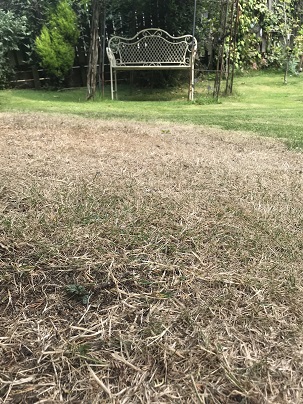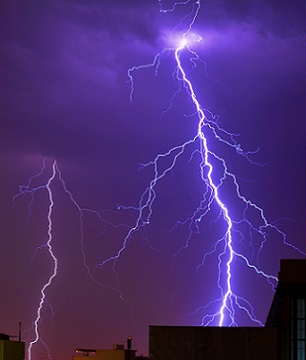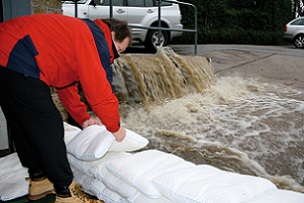 Parched grass can become impermeable to rainwater, leading to flash flooding. Photo by Andy Hirst from AH! PR
Parched grass can become impermeable to rainwater, leading to flash flooding. Photo by Andy Hirst from AH! PR
 Water from storms can quickly lead to flash flooding
Water from storms can quickly lead to flash flooding
 FloodSax alternative sandbags keep torrential floodwater out of homes and businesses
FloodSax alternative sandbags keep torrential floodwater out of homes and businesses
Why droughts lead to flash flooding
Droughts can lead to the worst ever flash floods in the UK and many people will be unprepared for the intensity of the rainfall and the ground’s complete inability to cope with it over the coming days and weeks.
The reason is that ground, especially soil and grass, becomes so bone hard dry that it’s like an ultra-hard surface such as cement, tarmac or paving slabs and the deluge of rainwater simply hits it and then runs off, flooding homes and business.
Couple this with the fact that local authorities have absolutely no responsibility to provide sandbags or other temporary anti-flood devices and it’s ‘the perfect storm’ where flooding becomes a virtual inevitability with all the misery and financial hardship that wreaks.
Many councils urge people to use alternative sandbags such as FloodSax sandless sandbags which are space-saving to store and quick and easy to deploy.
The Met Office is predicting storms and flash flooding virtually anywhere in the UK today and tomorrow with the storms more confined to the south on Wednesday.
A university has just carried out a simple yet highly effective and worrying experiment showing how droughts make the ground almost impermeable to rainwater and flash flooding.
Dr Rob Thompson from the University of Reading’s Meteorology Department carried out an experiment using three glasses of water to demonstrate how long it takes water to soak into the ground … and the results both surprised and shocked him.
In the first experiment the water is placed on wet grass and can be seen rapidly soaking into the ground. The second shows grass during a normal summer with the water still soaking in but slower.
The third experiment is the shocker though as the water is placed onto parched ground during a heatwave and struggles to absorb any of it.
Dr Thompson said it shows that torrential rain after a drought can be dangerous and could easily lead to highly damaging flash floods.
He added: “A lot of us recognise that dry ground is harder to get watered so I knew it was going to be a problem but was surprised at just how big the difference was.
“The wettest grass took just nine seconds to empty the glass, 52 seconds for the second one but I gave up with the driest one after four and a half minutes as you could see the water just wasn’t able to go anywhere.
“Imagine if we get heavy rain - it's going to land on top of the hard soil. It might evaporate if it becomes hot and sunny again, or it could run down and cause flash flooding, so is a real danger.”
So what’s the best way to slowly make drought-stricken ground more permeable again?
“What we need is hours of light rain that will slowly soak in,” said Dr Thompson.
To watch the experiment, click here https://bit.ly/3bQRH8R
So what must people do to be prepared for flash flooding?
Well, sandbags are not a good option according to The Environment Agency, which also warns: “Don’t assume the authorities will provide you with sand bags in a flood emergency. It’s the responsibility of property owners to take appropriate action to protect their property from flooding. Sandbags are relatively ineffective when compared to purpose-built flood protection products. We strongly encourage people to use these products.”
Many people don’t realise that local councils have absolutely no responsibility to provide sandbags and it’s down to people to protect their own properties from flash flooding, river flooding (known as fluvial flooding), groundwater flooding and sewer flooding.
That’s why FloodSax - which are also referred to as flood bags, flood sacks or even waterbags - are so important for flood mitigation.
They are vacuum-packed and when unwrapped resemble a large pillowcase but when FloodSax are immersed in water they absorb 20 litres which transforms them from being as light as a pillowcase to being more effective than traditional sandbags in around five minutes.
FloodSax are a multi-purpose product. In their dry state they are super-absorbent yet thin with a large surface area so are highly effective at soaking up drips, leaks, spills and floods inside homes and businesses, especially in hard-to-reach places such as beneath pipes, radiators, sinks and boilers.
They were invented in Yorkshire by Huddersfield-based company Environmental Defence Systems Ltd and almost 3 million have now been sold worldwide since 2007.